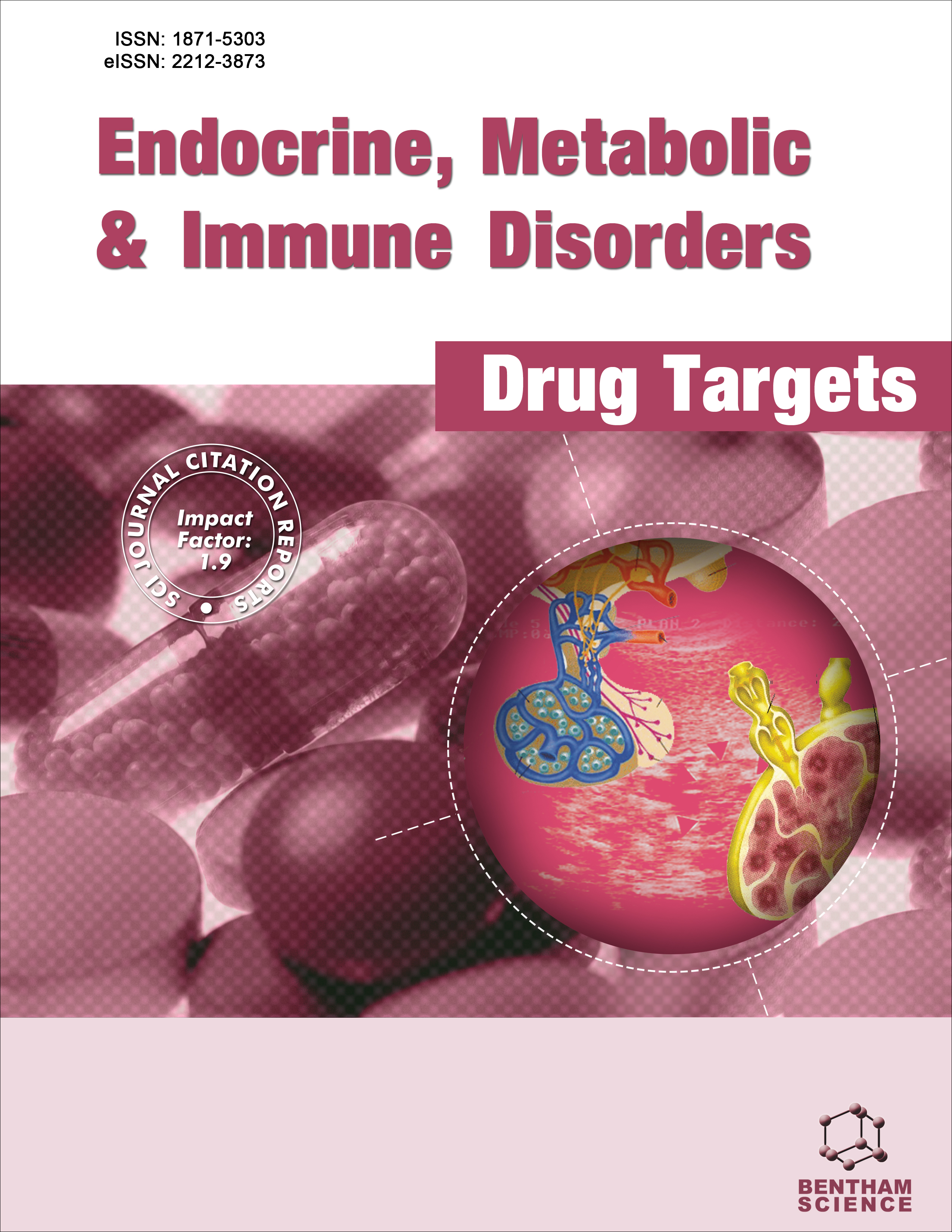- Home
- A-Z Publications
- Endocrine, Metabolic & Immune Disorders-Drug Targets (Formerly Current Drug Targets - Immune, Endocrine & Metabolic Disorders)
- Previous Issues
- Volume 11, Issue 2, 2011
Endocrine, Metabolic & Immune Disorders-Drug Targets (Formerly Current Drug Targets - Immune, Endocrine & Metabolic Disorders) - Volume 11, Issue 2, 2011
Volume 11, Issue 2, 2011
-
-
Editorial [Hot topic: Brave New World? Arrestin Pathway Bias in Drug Design (Guest Editor: Bradley T. Andresen)]
More LessAuthors: Bradley T. Andresen and Louis M. LuttrellThe phenomenon of G protein-coupled receptor (GPCR) ligand ‘bias’, the ability of an agonist to activate (or inhibit) only a part of its receptor's downstream signals, has been recognized for over 15 years [1]. ‘Bias’, or functional selectivity, can take many forms; from ‘reversal of potency’, where two ligands activate different signaling pathways with opposite potency, to outright ‘reversal of efficacy’ where a ligand that anta Read More
-
-
-
A Pharmacological Primer of Biased Agonism
More LessBiased agonism is one of the fastest growing topics in G protein-coupled receptor pharmacology; moreover, biased agonists are used in the clinic today: carvedilol (Coreg®) is a biased agonist of beta-adrenergic receptors. However, there is a general lack of understanding of biased agonism when compared to traditional pharmacological terminology. Therefore, this review is designed to provide a basic introduction to classica Read More
-
-
-
Functional Relevance of Biased Signaling at the Angiotensin II Type 1 Receptor
More LessAngiotensin II type 1 receptor antagonists (AT1R blockers, or ARBs) are used commonly in the treatment of cardiovascular disorders such as heart failure and hypertension. Their clinical success arises from their ability to prevent deleterious Gαq protein activation downstream of AT1R, which leads to a decrease in morbidity and mortality. Recent studies have identified AT1R ligands that concurrently inhibit Gαq protein-depend Read More
-
-
-
β-arrestin-Biased Agonism at the Parathyroid Hormone Receptor Uncouples Bone Formation from Bone Resorption
More LessAuthors: Brittany N. Bohinc and Diane Gesty-PalmerParathyroid hormone (PTH) is a principle regulator of bone and calcium metabolism and PTH analogs hold great promise as a therapy for metabolic bone diseases such as osteoporosis. PTH acts principally through the type I PTH/PTH-related peptide receptor (PTH1R), a G protein-coupled receptor (GPCR). GPCRs are a family of seven transmembrane cell surface receptors that share conserved structural, functional, and re Read More
-
-
-
Endogenous Ligand Bias by Chemokines: Implications at the Front Lines of Infection and Leukocyte Trafficking
More LessChemokine receptors are a group of homologous seven transmembrane receptors (7TMR) that direct cell migration. Their ligands comprise a family of proteins that share structural, biochemical, and physiological features to govern leukocyte trafficking. Multiple endogenous chemokines with overlapping function have evolved for the majority of chemokine receptors. This duplicity of ligands has traditionally been seen to c Read More
-
-
-
Advanced Glycation Endproducts and Diabetes. Beyond Vascular Complications
More LessAuthors: Alessandra Puddu and Giorgio L. VivianiAdvanced Glycation Endproducts (AGEs) are a group of heterogeneous compounds formed by the non enzymatic reactions between aldehydic group of reducing sugars with proteins, lipids or nucleic acids. Formation and accumulation of AGEs are related with the aging process and are accelerated in diabetes. Type 2 diabetes are the most common form of diabetes, which are characterized by hyperglycemia and insulin Read More
-
-
-
Chemokine Receptors as Specific Anti-Inflammatory Targets in Peripheral Nerves
More LessChemokines are the initial mediators of leukocyte migration across concentration gradients in vitro and to sites of inflammation in vivo. Chemokines signal via specific seven-transmembrane spanning G-protein coupled receptors (GPCRs). About 50 chemokine ligands and 18 receptors have been identified to date, and several are involved in leukocyte trafficking in human inflammation. Several chemokines signal via a single recept Read More
-
-
-
Approaches to the Pharmacological Modulation of Plasmacytoid Dendritic Cells
More LessAuthors: Dorit Fabricius and Bernd JahrsdorferHuman plasmacytoid dendritic cells (pDC) are crucial for the modulation of adaptive immune responses in the course of neoplastic, viral and autoimmune diseases. In several of these disorders deregulated pDC-derived interferon-α (IFN-α), a key cytokine produced by pDC, plays a central role. Apart from IFN-α, pDC can produce a variety of other mediators, which are involved in immunological cross-talk. The most recently Read More
-
-
-
The Role of Eosinophils in Non-Parasitic Infections
More LessAuthors: Stefanie N. Linch and Jeffrey A. GoldEosinophils are a subset of leukocytes the traditionally associated with Th2-related diseases and helminth infections. However, accumulating evidence suggests that eosinophils play a more prominent role in the immune response to bacterial and viral pathogens than previously realized. Specifically, eosinophils possess antimicrobial properties against a broad range of pathogens, and release specific and secondary granul Read More
-
-
-
The Search for Immunosuppressive Therapies to Induce Tolerance in Organ Transplantation
More LessAuthors: Kuei-Chen Chiang, Naoya Ohmori and Takeshi GotoOrgan transplantation has become a major therapeutic option for patients with irreversible organ diseases. Immunosuppressive agents are usually required to prevent allograft rejection in patients who undergo an organ transplantation. Such drugs suppress both specific and nonspecific immunity, and render the recipient more susceptible to both infection and malignancy. Therefore, the development of more effective an Read More
-
Volumes & issues
-
Volume 25 (2025)
-
Volume 24 (2024)
-
Volume 23 (2023)
-
Volume 22 (2022)
-
Volume 21 (2021)
-
Volume 20 (2020)
-
Volume 19 (2019)
-
Volume 18 (2018)
-
Volume 17 (2017)
-
Volume 16 (2016)
-
Volume 15 (2015)
-
Volume 14 (2014)
-
Volume 13 (2013)
-
Volume 12 (2012)
-
Volume 11 (2011)
-
Volume 10 (2010)
-
Volume 9 (2009)
-
Volume 8 (2008)
-
Volume 7 (2007)
-
Volume 6 (2006)
Most Read This Month
Article
content/journals/emiddt
Journal
10
5
false
en


